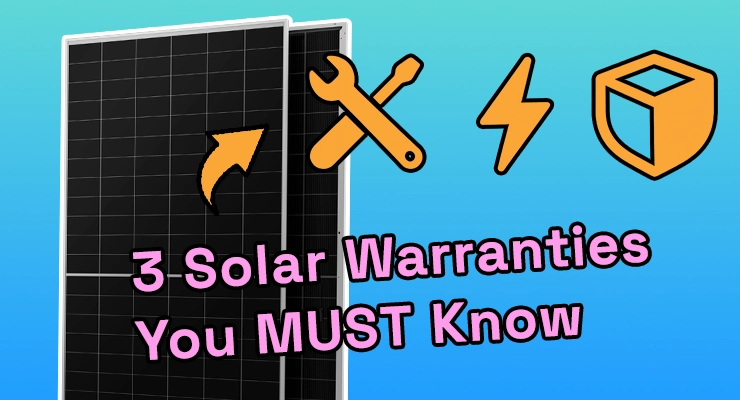Fast read
When investing in a solar system in Australia, you are protected by three key warranties: a product warranty for physical defects, a performance warranty for energy output, and an installer's workmanship warranty for the quality of the installation. The product warranty and the installer's warranty are the most critical for protecting you against failures and faults. Always verify that your chosen components come from manufacturers with a strong Australian presence and that your installer is a Clean Energy Council (CEC) accredited professional.
What are the key solar warranties?
Navigating the world of solar energy can feel complex, but understanding the warranties that protect your investment is one of the most powerful steps you can take. A solar system is a long-term asset, and robust warranties provide peace of mind that it will perform as expected for decades to come. In Australia, your system is protected by a combination of manufacturer and installer warranties, in addition to your automatic rights under Australian Consumer Law.
It’s helpful to think of your solar warranties not as a single guarantee, but as three distinct pillars of protection, each covering a different aspect of your system.
What is a product warranty?
A product warranty, often called a manufacturer’s or materials warranty, is your protection against physical defects in the hardware itself. It covers faults in materials and workmanship that cause the product to fail. Think of it like the warranty on a new television or appliance.
For solar panels, this could cover issues like:
- Delamination (the layers of the panel separating).
- Frame corrosion or defects.
- Faulty junction boxes or connectors.
- Micro-cracks that occurred during manufacturing.
This is arguably the most important warranty to consider. If a panel completely stops working, it’s the product warranty you’ll rely on. For solar panels, product warranties have improved significantly, with many reputable brands now offering 15, 25, or even 30 years of coverage. For example, AIKO, a manufacturer of high-efficiency panels, provides a 25-year product warranty on their main residential modules.
For other components, like inverters and batteries, the product warranty is just as crucial. A quality inverter should have a warranty of at least 10 years. Sungrow, a popular inverter brand in Australia, offers a 10-year standard warranty on many of its residential inverters. Similarly, home batteries typically come with a 10-year product warranty. This is offered by major brands like Sigenergy for their SigenStor systems.
What is a performance warranty?
The performance warranty guarantees that your solar panels will maintain a certain level of electricity production over their lifetime. All solar panels experience a slow, gradual decline in power output over time—this is called degradation. A performance warranty ensures this degradation doesn’t exceed a specific, guaranteed rate.
Typically, a performance warranty might guarantee that the panels will still produce at least 90% of their original rated power after 10 years and 80-85% after 25 years. Many modern high-quality panels offer a linear performance warranty, which guarantees a maximum degradation rate each year. For instance, Aiko’s 30-year performance warranty ensures their panels will still produce at least 88.85% of their original output after three decades.
While this sounds great, claiming a performance warranty can be difficult. It requires proving that a drop in your system’s output is due to the excessive degradation of a specific panel, rather than other factors like dirt, shading, or inverter issues. In practice, a major fault that would cause a significant drop in performance is often covered by the more straightforward product warranty.
What is an installer’s workmanship warranty?
The workmanship warranty (also called an installation warranty) is provided by the company that installs your system. This warranty is critical as it covers the quality of the installation work itself. A poor installation can lead to a host of problems, from water leaks to electrical faults, and can even void your manufacturer’s warranties.
A workmanship warranty covers issues arising from the installation, such as:
- Leaking roof penetrations are caused by the mounting system.
- Faulty wiring or loose connections.
- Incorrectly mounted panels or components.
- Water damage to the inverter due to poor placement.
In Australia, Clean Energy Council (CEC) Approved Solar Retailers are required to provide a minimum five-year, whole-system warranty, which includes workmanship. However, many reputable installers offer longer periods, often up to 10 years, as a sign of their confidence in their work. This warranty is your first point of contact for any system-wide issues.
Key questions to ask your solar provider about warranties
To ensure you are fully protected, it’s essential to ask your potential installer specific questions before signing a contract. This clarity can save you significant stress and expense down the track.
- Who is responsible for warranty claims? Your installer should be your first point of contact and should manage any product warranty claims with the manufacturer on your behalf. This is crucial, as they can diagnose the fault and handle the logistics of getting a replacement.
- Are labour costs covered for replacements? This is a critical detail. Some product warranties only cover the replacement part, not the labour costs for the electrician to diagnose the issue, remove the faulty component, and install the new one. Check if the manufacturer’s warranty or the installer’s workmanship warranty covers this.
- What happens if the installer goes out of business? While your product warranties remain valid with the manufacturer, you would lose your workmanship warranty. This is a strong reason to choose an established installer and manufacturers with a direct Australian presence, including a local office and support team.
- Are the warranties transferable? If you sell your home, most manufacturer warranties for panels and inverters can be transferred to the new owner, which can be a valuable selling point. Always confirm the process, as some policies require notification to the manufacturer.
Navigating the warranty claim process
If you suspect an issue with your system, the process should be straightforward.
First, contact your original installer. They are familiar with your system and are responsible for the workmanship warranty. They will perform troubleshooting to diagnose the problem.
If the fault lies with a component like a panel or an inverter, they will then initiate a claim with the manufacturer. You will likely need to provide proof of purchase and the serial number of the faulty product.
A good installer will manage this entire process for you. Choosing a reputable solar company with a long history and positive reviews is just as important as choosing high-quality components with strong warranties.
Ultimately, by understanding these three key warranty types and asking the right questions, you can feel confident that your investment in a renewable energy future is safe, secure, and built to last.





